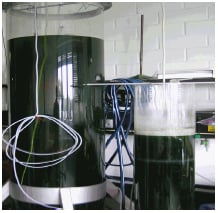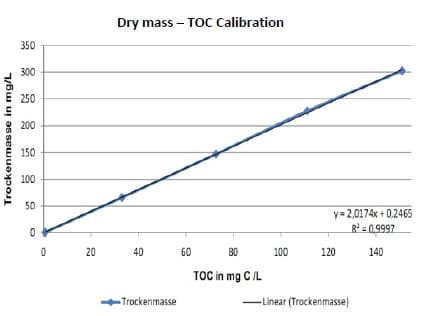TOC - determination in algal biomass - suspension method

The excessive global CO2 emissions from the burning of fossil fuels (for instance in power plants) causes the search for climate-friendly uses of carbon dioxide. One of the approaches for environmentally sound recycling is to convert the emitted CO2 into biomass using photobioreactors. The CO2 gas is introduced into the photobioreactor in order to be used for the growth of algae.
The biomass, or algae, can be used in many different application areas: in the cosmetics industry, the construction industry, and the food segment, in agriculture as fertilizer or for energy utilization.
Sample preparation
The 4 – 10 μm large micro-algae of the Chlorella vulgaris species can be measured directly after sampling from the reactor without any further sample preparation. The difference method was used for the biomass determination. The method is suitable for all other single-cell algae that exhibit a stable carbon content under different growth conditions. Using the difference method, the TC and TIC were determined and the TOC was subsequently calculated from these values. Calibration using the resulting dry mass of the algae makes it possible to draw conclusions on the dry biomass content in the sample from the TOC.
Corrrelation

The TOC correlation (algae biomass/TOC) must be determined for each type of algae specifically. It can also be calibrated against the determined dry mass.
First, the algae sample is measured and the TOC is determined. Subsequently, the sample is filtered through a 0.2 μm syringe filter and measured again in the TOC analyzer to be able to distinguish between the TOC content originating from the algae and the carbon content possibly originating from the extracellular substances produced by the algae or released into the culture medium after the algae have died off. The TOC determined this way is the carbon content of the investigated algae. To draw conclusions on the dry mass yield, the percentage carbon content in the algae must be determined.
TOC-L series
The TOC-L series of TOC analyzers adopts the 680°C combustion catalytic oxidation method, which was developed by Shimadzu and is now used worldwide. While providing an ultra wide range of 4 μg/L to 30,000 mg/L, these analyzers boast a detection limit of 4 μg/L through coordination with NDIR. This is the highest level of detection sensitivity available with the combustion catalytic oxidation method.
In addition, the combustion catalytic oxidation method makes it possible to efficiently oxidize not only easily-decomposed, low-molecular-weight organic compounds, but also hard-to-decompose insoluble and macromolecular organic compounds.



